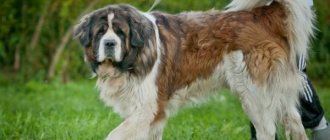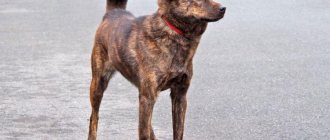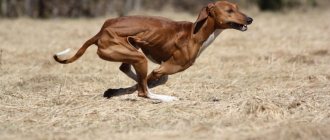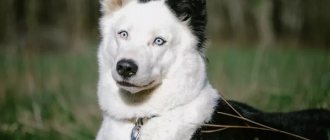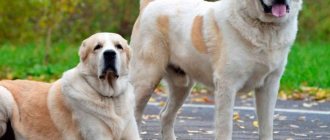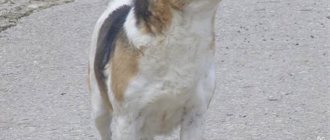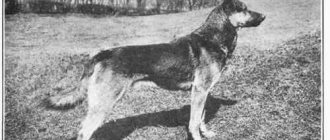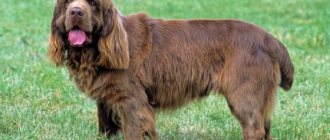Breed characteristics
| Short description | |
| Origin: | Hungary |
| Conditions of detention: | House, local area |
| Purpose: | Hunting dog, companion |
| Color: | Red-golden, red |
| Wool length: | Short, smooth coat or medium-length harsh coat |
| Adult dog size: | The height of the female is 54-60 cm, the male is 58-64; male weight – 25-27 kg, female – 20-25 kg |
| Average life expectancy: | 12-14 years old |
| Walk: | A long walk twice a day is required, even when kept on the street. |
| Physical activity needs: | High physical activity needs (hunting, jogging, swimming) |
| Fédération Cynologique Internationale (FIC) classification: | Group 7: cops; section: continental pointers |
| Puppy price: | From 42,000 rubles to 80,000 rubles. Pet class – up to 45,000 rubles, breed class – up to 60,000 rubles, show class – 70,000-80,000 rubles. |
In this article we will talk about a rather rare breed of pointing dogs - the Hungarian Vizsla . These are very obedient, hardy, reliable, quick-witted and unpretentious hunting dogs with good scent and sharp eyesight. Fast and swift bloodhounds, excellent at working on small game. In addition, these dogs can easily help you get a wounded animal, since they are good at working “by blood.” The Hungarian Vizsla is an excellent choice for a novice dog breeder!
Origin of the breed
Vizsla (vizsgál) - in Hungarian means “to seek, to study.”
The ancestors of the Hungarian pointer were dogs that accompanied the nomadic Magyar tribes. As you know, nomads paid special attention to hunting as their main livelihood. Later, these dogs became interested in Hungarian hunters and they began to breed them, and at the same time, improve their working qualities. The dogs began to be crossed with pointers of eastern origin, and then with Russian greyhounds, as a result their appearance changed significantly, and their coat acquired a lighter shade. Then, in the first quarter the 16th century, when Hungary was occupied by Turkish troops, the dogs were crossed with the Salukis (sand-colored greyhounds) that accompanied the Turkish troops. As a result of crossing, it was possible to develop good hunting dogs, golden in color, which were highly valued in noble circles. These hunting dogs were used for hunting birds and fur-bearing animals. The cops did their job well both in the field and in the forest, and also gladly rushed into the water to catch dead game, then carried it away.
The work on developing and improving the working qualities of this dog breed did not end there. In the 17th century , the selection of these wonderful dogs was headed by a breeder named Zai. He became the founder of a new breeding program that lasted for about 150 years in the city of Zaingrotsch, where breeders worked hard to improve the conformation and working qualities of pointers by crossing them with Hanoverian hounds, pointers, shorthaired pointers and poodles. As a result, they managed to breed universal gun dogs, which became the national treasure of Hungary.
However, in the 19th century, due to German pointers with excellent field qualities, interest in Vizslas began to fade, even in their historical homeland - Hungary.
In 1935 , the Fédération Cynologique Internationale finally recognized the Hungarian Vizsla breed. Since then, these dogs have become much more common in European countries. Vizslas also began to be imported to the USA and Canada, where dog handlers made great efforts to select and increase their numbers. By the way, thanks to their efforts, the breed was saved from extinction after the Second World War, since the Hungarians, being under Nazi occupation, decided to kill all the dogs so that they would not fall into the hands of enemy soldiers as war trophies.
Despite the fact that Pointers had greater stamina and aesthetics, thereby attracting the attention of a significant number of hunters, the Hungarian Vizslas were more versatile.
Physical Features
The Hungarian Shorthaired Pointer is a medium-sized, elegant dog with a short, yellowish coat according to the Fédération Cynologique Internationale standard. This is a light and thin dog, but at the same time incredibly muscular and strong.
Its body is slightly longer than its height, giving the dog a slightly rectangular profile. The back is strong, straight and muscular. The spine is short and wide. The chest is wide and deep. The lower line of the body forms an elegant curve at the level of the abdomen.
The Vizsla's head looks somewhat aristocratic. The skull is wide, slightly arched. It is a thin groove that runs from the back of the head to the nasolabial cavity. The nose is wide and well developed. It should be a shade slightly darker than the robe, in harmony with the coat. The muzzle is blunt with a straight nasal bone. The eyes are oval, medium-sized, lively. They are brown and preferably a dark shade, although amber or yellow eyes are common in this breed. The ears are thin and hang to one side. The tail is low and thick at the base. When the dog is active, its tail is raised horizontally.
The coat of the Hungarian Pointer is short, dense and harsh. It covers the entire body without inner undercoat. The color may appear as any shade of yellow, but a slight white patch on the chest and small white lines on the toes are acceptable (although this is not desirable).
The height of the Vizsla, according to the Fédération Cynologique Internationale standard, should be between 58 and 64 centimeters for males and between 52 and 60 centimeters for females. This standard does not indicate an ideal weight, but males typically weigh between 20 and 27 kilograms, while females weigh between 18 and 25 kilograms.
Coat type: short, dense, hard and coarse. There is no undercoat.
Color (FCI standard): rich red with a golden tint.
Height at withers: males - 58-64 cm, females - 52-60 cm
Weight: males - 20-27 kg, females - 18-25 kg.
Average life expectancy: 12-15 years.
Country of origin: Hungary.
Origin of the breed: XVIII century.
>Learn about other breeds of pointing dogs
You might be interested in:
Minor modifications to Saiga-308-1 isp.61
Today I picked up my parcel from one specialized store. Here's what I ordered: a shock absorber backplate for the buttstock from Alfa Arms , a polyurethane recoil buffer Top for the recoil spring, and also some weapons chemicals for cleaning and lubricating the weapon. With the help of this butt plate, I finally increased the length of the butt that was missing for me, and the buffer should soften the impact of the bolt frame on the receiver and prevent the formation of hardening. This is not the first time I have purchased a polyurethane buffer; a similar part has been working on my AKMS-MF1 7.62x39 for more than 8 years and I have no complaints about its performance.
Read more…
Mallard
Mallard (lat. Anas platyrhynchos) is a bird from the duck family (Anatidae) of the order Anseriformes. The most common and famous wild river duck. It has a large habitat and is widely distributed in the northern hemisphere. Partially migratory bird. From this species, through selection, most modern breeds of domestic ducks were bred. The body length of an adult is 51-62 cm, wingspan 80-100 cm, body weight 0.8-1.5 kg. (before the flight, the body weight of an adult male can reach 2 kg). It is the object of amateur and commercial hunting. Life expectancy in the wild is 15-20 years.
Read more…
Instructions for upgrading a standard 8-local Saiga-308-1 magazine into a 10-local one
I, like many other owners of Saiga-308-1 , was interested in the question “is it possible to improve the standard 8 -local magazines that come with the kit so that they turn into 10 -local?” It turns out that it is possible and, moreover, it is not difficult. To do this you will need a ruler, a hacksaw (or grinder) and pliers. The whole process is actually quite simple and does not require special skills...
Read more…
Share with friends!
History of the origin of the species
Dogs appeared back in the 10th century, they came to the mainland along with the nomadic Magyars, who hunted for survival. Later, the nomads settled in the region where Hungary is now located, became townspeople, and later - aristocrats. Thus the Vizsla became a breed of nobility.
"Vizsla" means "to seek" in Hungarian.
The dogs were crossed with local pointers and gundogs, which resulted in a short, shiny coat and impeccable working qualities. The law prohibited exporting the Vizsla abroad, because the breed was considered the property of the country.
Official breeding of dogs began in the 20s of the 20th century, when dog handlers tried to save the Hungarian Pointer from extinction. The standard was awarded to the breed in 1936. And a little later, the wirehaired Hungarian Vizsla was created (by mixing with the German Wirehaired Pointer). But this breed is registered separately.
Hungarian Vizsla price
The price of Hungarian Pointer puppies is determined by several factors:
- location and popularity of the nursery;
- class of the dog - for participation in exhibitions (shows), breeding (breeding) or keeping as a pet (pet);
- characteristics of the animal (including compliance with the breed standard);
- awards and titles from parents.
The average cost of a Hungarian Vizsla varies from 10,000 to 40,000 rubles. Dogs with an elite pedigree can cost owners more money, while animals with defects cost less. People from the poultry market are attracted by their low price, but there is a high risk of buying a non-purebred dog with a weakened immune system. You should not spare money on your future companion, because the joyful moments that communication with a Hungarian Vizsla will give are priceless!
LAIKA: HISTORY OF THE DOG AND CHARACTER
PUG: HISTORY OF THE BREED AND CHARACTER OF THE DOG
GERMAN SHEPHERD - HISTORY OF THE BREED AND CHARACTER
TIBETAN MASTIFF - HISTORY OF THE ORIGIN OF THE BREED
Distinctive features
The Vizsla is a lean, medium-sized dog, reaching 54-64 cm at the withers and weighing up to 27 kg. The breed is characterized by a streamlined, dry body, long limbs, and a proud carriage of the head. We can say that the Cops look aristocratic.
- Head with a dry skull, moderately wide between the ears. Cheekbones and brow ridges are clearly visible.
- The muzzle is square with a straight bridge of the nose. The jaws are strong, have a scissor bite, and have a full set of teeth. The lips are slightly jagged.
- The nose is large and reddish brown.
- The eyes are small, almond-shaped, brown or dark in color.
- The ears are long, round, set low, and fit tightly to the head.
- The body is rectangular, dry, strong. The topline is slightly sloping. The croup is rounded. The neck is long, moderately thick. The belly is tucked in. The chest is of medium volume.
- The tail is long, thin, set low, saber-shaped.
- The limbs are straight, long, strong with well-developed muscles. Paws are rounded.
- The coat is double-layered and lies tightly to the skin.
- Color – red-golden, red-brown.
What does a Hungarian Vizsla dog look like?
The Hungarian Vizsla is an elegant gun dog with a noble appearance and a golden-red coat that emphasizes the harmony of strength and beauty. Height at withers – 54-64 cm, weight – 22-30 kg. In addition to the smooth-haired Hungarian Pointer (FCI standard No. 57), there is a wire-haired variety, which is recognized by the FCI as a separate breed with its own standard (No. 239).
The head is dry and proportional to the body. The skull is slightly convex, of moderate width. The longitudinal groove stretches from the moderately pronounced occipital protuberance to the smooth stop. The nose is wide, large with well-developed mobile nostrils. The color is light brown; the eyelids and lips should be the same color. According to the standard, the nose should not be black or brown.
The muzzle is dull. The bridge of the nose is straight. The jaws are well developed. The lips fit tightly. Scissor bite, dense. The eyes are medium in size, set slightly slanted. The preferred color is dark brown. The ears are set low, wide at the base, but tapering towards the tip. The length of the ear is 1/3 of the entire head.
The body has an almost square format: the height at the withers is only slightly less than the length. The depth of the chest is slightly less than the height. The withers are well defined and flow into a strong, straight back. The spine should be hidden under a layer of muscle. The chest is deep, wide, the ribs are moderately elongated. Bottom line with a slightly noticeable undercut. The tail is set quite low at the base and is thick. Can be docked at 1/4 length.
Undocked reaches the hocks. When moving, the Vizsla carries it horizontally or sickle at the level of the back. Both fore and hind legs are straight, parallel, with well-developed lean muscles and strong ligaments.
Dense short hair covers the entire body. It feels rough and hard to the touch. There is no undercoat. On the ears and head the hair is slightly shorter and softer. The hair on the lower part of the tail is slightly longer, and on the belly it is sparser than on the body. The coat color ranges from wheat to reddish-golden in different shades.
The fur on the ears may be slightly darker. A white spot on the chest with a diameter of no more than 5 cm, as well as marks on the fingers, are allowed.
Who is the Hungarian Vizsla often confused with?
Externally, the Hungarian Vizsla is a bit similar to the Rhodesian Ridgeback. In some photos the breeds can be easily confused. In addition, breeders are often asked when gray puppies will be available. The gray Hungarian Vizsla does not exist. The standard allows only one color - golden red. But the Weimaraner, which has some similarities with the Hungarian pointer, can be gray, and only gray.
Photo of an adult dog
Photos of puppies
Features of character and behavior
The Hungarian Vizsla is not your typical hunting dog. The breed is friendly to others. The animal gets along well with all strangers, never gets into conflicts, and does not “quarrel” even with cats and small rodents. The cop loves children, will play with them, but is unlikely to protect them from an enemy, because for this dog there are no bad people.
The Vizsla is very active, tireless, and hardy . She is ready to hunt all day long without feeling overtired. Animals have well-developed intellect and instinct; from birth they have all the necessary skills for work (stand up, follow the scent).
Another feature of the Hungarian Pointer is its attachment to humans. A dog cannot live without its owner for even a minute. She constantly needs contact with her family.
How does a Vizsla behave when hunting?
The Hungarian Vizsla stays close to its owner. It is important for her that the owner is always in sight. The pace of the hunt is calm, which allows you to save energy for a long pursuit. Survival is great for those who prefer to hunt at a relaxed pace.
When hunting, the dog behaves carefully and quietly, making sure not to scare away the prey. While a pointer can rush past game in excitement, this will not happen to a vizsla. It is difficult to find a more suitable dog for hunting birds in swamp thickets or forests. Sometimes the Vizsla is used in hunting hares.
Those who are planning to hunt with a survivor should take into account that already in the middle of autumn it may be cold (in the middle climate zone) there is no need to talk about winter and frost.
The Hungarian Pointer has proven itself to be an excellent pointer and skillful retriever. Even if the game gets into dense thickets, she will readily bring it. Without hesitation, the dog jumps into cold water for prey, but active hunting for waterfowl in the cold season can be an extreme activity for a short-haired dog.
Hungarian Vizsla at work (video):
Advantages
Owners of Hungarian Coppers dote on their pets. How can you not love such loyal and intelligent animals? Breeders boldly declare the main advantages of the breed:
- Sociability, lack of aggression, friendliness to people and animals;
- Love for children;
- Mobility, energy;
- Balance, calmness;
- Sensitivity (the dog senses emotional fluctuations, knows when to approach the owner and when not to);
- Unobtrusiveness;
- Loving nature;
- Developed intelligence and quick learner.
Care and maintenance
The Vizsla is a fairly large dog, which is simply inconvenient to keep in an apartment. But Cop doesn’t care what conditions he lives in, the main thing is to be close to a person. After all, animals have worked side by side with people since ancient times.
It is better for the Hungarian Vizsla to be in a large country house with free access to the street . The breed is not suitable for chains or kennels. Keeping in a kennel is acceptable provided there is frequent contact with the family and the ability to enter the house at any time.
Such a pet does not require special conditions and careful care. But it needs frequent long walks and constant attention from household members. Before buying a dog, it is important to purchase a heated bed or kennel (you can build it yourself), height-adjustable bowls, toys, a collar and a leash.
Nutrition
Cops are not picky. They will eat what they are used to from puppyhood.
- Babies up to 1.5 months are fed by the mother, later complementary foods are introduced in the form of milk porridges.
- At 2-2.5 months it is already allowed to give grated boiled meat and baked apples.
- From 3 months it is possible to switch to baby dry food (must be softened with water or kefir before serving).
Ready-made food makes keeping a dog much easier. The products do not need to be boiled or diluted additionally, just determine the serving size. Moreover, high-quality food contains the necessary complex of vitamins and minerals, so there is no need to worry about balancing the diet.
Any super-premium class food for active breeds (or hunting breeds) of medium and large sizes is suitable. It is important that the composition does not contain dyes, preservatives, flavor enhancers, corn or wheat. Meat should come first (from 35%).
Dry food is convenient due to its variety. You can choose a product for puppies, pregnant females, sick and elderly dogs, and allergy sufferers.
Natural food is more difficult to prepare, but it is often cheaper than complex feed. It will not be possible to achieve a complete balance of microelements, so you will have to introduce vitamin supplements.
- A serving should consist of 40% meat: chicken, beef, turkey, rabbit.
- Other proteins will also work: kefir, cottage cheese, sea fish, eggs.
- Carbohydrates – buckwheat, oatmeal and rice, cooked in water.
- Fats – fish, including Omega-3, and vegetable oils (linseed or olive).
- It is useful to add raw or boiled vegetables (carrots, beets) and fruits (apple, pear).
The serving size depends on the age and weight of the dog. Up to a year, puppies are fed 3-5 times, 200-250 grams. Adult pets – 2 times a day, 400-600 grams.
Prohibited foods include bones, potatoes, flour and confectionery products, onions and garlic, tea, alcohol, fatty, fried, butter and pork. It is not recommended to give milk to dogs older than 3 months.
We recommend that you read a detailed article on the topic: “How and what to feed a dog: types and characteristics of nutrition.”
Health
The Hungarian Vizsla can be called a strong dog. With its rather large size, the Pointer lives up to 1 2-13 years , and with proper care - up to 15-16 . The main thing is to follow the training regime, feed your pet properly, take it to the veterinary clinic for examinations every 5-6 months and get vaccinations according to age.
Vaccinations
Hunting breeds need timely vaccination more than others. Instinct guides even an untrained dog. Vizslas often bring killed game found in the plantings or bushes near the house.
Contact with wild animals and birds increases the risk of infection with dangerous viruses that the immune system cannot cope with.
- The club that sells the puppies is responsible for the first vaccination But private breeders rarely vaccinate newborns, so it is better for the owner to find out whether the procedure was carried out.
- According to the schedule, the first injection should be given at 2.5 months, when the puppy’s immunity ceases to be fueled by the mother’s immune cells obtained from breast milk. Inactive strains of parainfluenza, adenovirus, enteritis, hepatitis and distemper are introduced.
- After a couple of weeks, the procedure is repeated and strains of leptospirosis are added to the serum.
- At 7 months they are vaccinated against rabies, at 12 months all vaccinations done previously are repeated.
- Annual revaccination is required, the duration of the drugs is designed for 12-20 months . After this period, the strains cease to act and the dog’s immune system “loses its vigilance.”
Important article on the topic: “Everything you need to know about dog vaccinations.”
The above vaccinations are considered mandatory. Without them, the dog cannot be walked in public places, transported across the border, or knitted. There are also additional vaccinations against piroplasmosis and lichen. The owner can give them to the pet at will, for example, at a time of exacerbation of diseases in the region.
On the day of vaccination, the dog must be healthy. Therefore, 2 weeks before the procedure, cleansing of helminths and ectoparasites is carried out. Lethargic animals with fever and other symptoms are not allowed for vaccination.
Diseases
Breeders try to cull individuals with hereditary (congenital or manifest) diseases. However, genetic health problems occur in 40% of cops. The following diseases are most often diagnosed in the breed:
- Oncology;
- Hypothyroidism (thyroid dysfunction);
- Hip dysplasia;
- Glaucoma and cataracts;
- Retinal atrophy;
- Atopic dermatitis;
- Poor blood clotting (hemophilia);
- Von Willebrand's disease (as progressive hemophilia).
Walk
Walking is vital for the breed . Even if the dog lives outside in a kennel or enclosure and walks freely around the yard, it is imperative to take him outside a limited area (into the forest, planting, field, dog park).
You need to run a lot. An owner who is not a hunter can give the pet a chase after a mechanical hare. Cops like to chase a ball and go through an agility course. Such a four-legged friend will share any sports hobbies: swimming, cycling or rollerblading, tennis.
On average, an adult Hungarian Pointer requires 2 walks (morning and evening) for 2-3 hours. Puppies are walked 3-4 times a day for 40-80 minutes.
Grooming
These dogs require virtually no grooming. Their short coat is considered hypoallergenic, although they shed twice a year. Brush it once every 2 weeks with a glove brush. During the seasonal coat change period, it is better to wipe the dog with a fleecy cloth every 10 days.
are bathed once a month with gentle detergents. In the summer, dogs can and should be taken to natural bodies of water so that they can rinse off and swim to their heart's content. Be sure to wash your paws after every walk.
The breed has a weak spot – the ears. Due to the hanging position, the ear canal is not ventilated, moisture accumulates there, and pathogens multiply. You can prevent the development of otitis media if you inspect your pet’s ears daily and clean them of wax accumulations.
The nails of hunting breeds are rarely trimmed, but if the dog is kept in a house or apartment, the plates do not wear off by friction against the asphalt. Then you need to shorten them every month. Teeth are brushed every week. You can use traditional tools (a brush and dog toothpaste), rubber toys with bristles, or chewing sticks.
Mating
Hungarian Vizslas are rare hunting dogs for which it is important to preserve their working skills in their natural state, therefore all matings must be official, club, sealed by an agreement. To ensure a high-quality litter, breeders make pairs of opposite dogs that complement each other’s strengths and weaknesses.
Large dogs require the intervention of a professional in mating. It is not so easy to help them, because you need to keep the female and male in one position for 15-20 minutes while the “lock” lasts. Vizslas are quite heavy, so the strength of both owners and the dog handler will be needed.
Pets are untied at 2 years old, then the maturation stage is completed, dogs are able to conceive, bear and give birth to healthy offspring. The female is brought to the territory of the male; you can walk the animals in advance and introduce them. On average, the act lasts 20-30 minutes.
Read a detailed article on the topic: “Everything you need to know about breeding dogs: appropriate age, what to do if it doesn’t work out, rules and tips.”
Key points in training
The Hungarian Vizsla is a highly intelligent dog, it learns quickly and does not strive for leadership in tandem with its owner. The cop is obedient, especially if raised from childhood . It’s easy to get her interested in play training. It is better to motivate the Vizsla with toys; goodies are also suitable, but balls, rings and other attributes will be a real joy for the dog.
It is not necessary to train the Cop to hunt; she has innate skills in finding and catching game. But special training will further reveal the animal’s potential.
The Vizsla puppy is kept indoors for up to 3 months. At this time, you can give your baby all the basic rules of behavior. The dog must know the feeding and walking schedule and follow the regime. The pet needs to learn its name, basic commands (“sit”, “lie down”, “no”, “place”, “next to me”, “to me”).
Read about how to properly train a dog in the article: “Training a puppy: effective methods from dog handlers, learning commands at home.”
Where to buy a puppy: nurseries
The main feature of Hungarian Vizsla puppies is a sad, folded muzzle, decorated with long ears, disproportionately large in relation to the head. The proportions of the body are preserved - long body, thick paws, strong neck. The color of the Pointer does not change with age, but may darken slightly.
When choosing a puppy, it is important to pay attention to possible congenital pathologies or changes in appearance that deviate from the standard. It is better to purchase a baby from nurseries or breed clubs. Although the Hungarian Pointer is not particularly popular, you can find an official breeder in Russia:
- Moscow "Tina Trading";
- Stavropol "ALEKSTIANA";
- Yaroslavl “Beauty of Fire”;
- St. Petersburg "Lembo Prout".
Photos
In the gallery you can look at photos of puppies and adult dogs of the Hungarian Vizsla breed (Hungarian shorthaired pointer).
A breed of extraordinary beauty, grace itself - the Hungarian Pointer or Vizsla. A dog with a royal, proud and stately head carriage, a lean, slender body, and long limbs. In addition to external ideal characteristics, Vizsla has good hunting skills.
Owner reviews
The breed does not cause negative feedback from owners, breeders or uninterested people. Vizslas are not aggressive, but intelligent. Suitable for family life and hermit hunters.
- Drew : “Great dog, kind, affectionate, smart and loyal. This is a good hunter, even without special training, the Pointer will stand up and bring game. A loving pet, she adores everyone who approaches her, very playful. The downside is that walking is difficult. Such a dog requires constant movement, sometimes there is simply no strength to go outside for 3 hours, but without such a walk the Vizsla will “wither”.
- Diana : “This is not a couch dog. The Hungarian Vizsla is an expensive, rare breed, and there is no point in owning one for the amusement of children or for personal joy if the family is not ready for constant walking, training, and hunting trips. Cops are the smartest animals, kind and sweet. But they are very closely connected with the owner, do not tolerate separation, and require a lot of attention and care.”
- Igor : “An excellent hunting dog, I trained it myself as best I could. He follows the trail and reacts instantly to the gun. A good smart pet, a close friend, fun for children. The Vizsla gets along well with the whole family, but only recognizes one leader, which suits me.”
Breeding and maintaining a hunting breed is always a big responsibility. Such pets are large, often get sick, and require training, constant training and walking. But, despite the long list of rules for care and education, those who are not afraid to get a Hungarian Pointer will be very lucky with their four-legged friend. After all, they will receive a forever devoted huge heart full of love.
Character
The Hungarian Vizsla has a balanced temperament. These dogs are cheerful and friendly, they are easy to train and express a desire to constantly be with their owner. This is a real Velcro dog and you will have to get used to the fact that she will poke her red wet nose into any family matters. The Hungarian Vizsla is very affectionate, she quickly becomes attached to family members and is devoted to them to the tips of her ears. Although, as a rule, only one is recognized as the real owner.
The Hungarian Vizsla is a real bundle of energy that requires daily, long walks, regular training and attention.
If the dog does not receive this at the proper level, it becomes problematic in terms of behavior and obedience. When a Vizsla spends a lot of time alone in the yard, it develops bad habits: crying for no reason, digging holes. The Vizsla is very smart, can achieve what it wants by cunning, but almost never puts its own interests above those of its owner. At the same time, she is very sensitive and cannot stand rough treatment.
